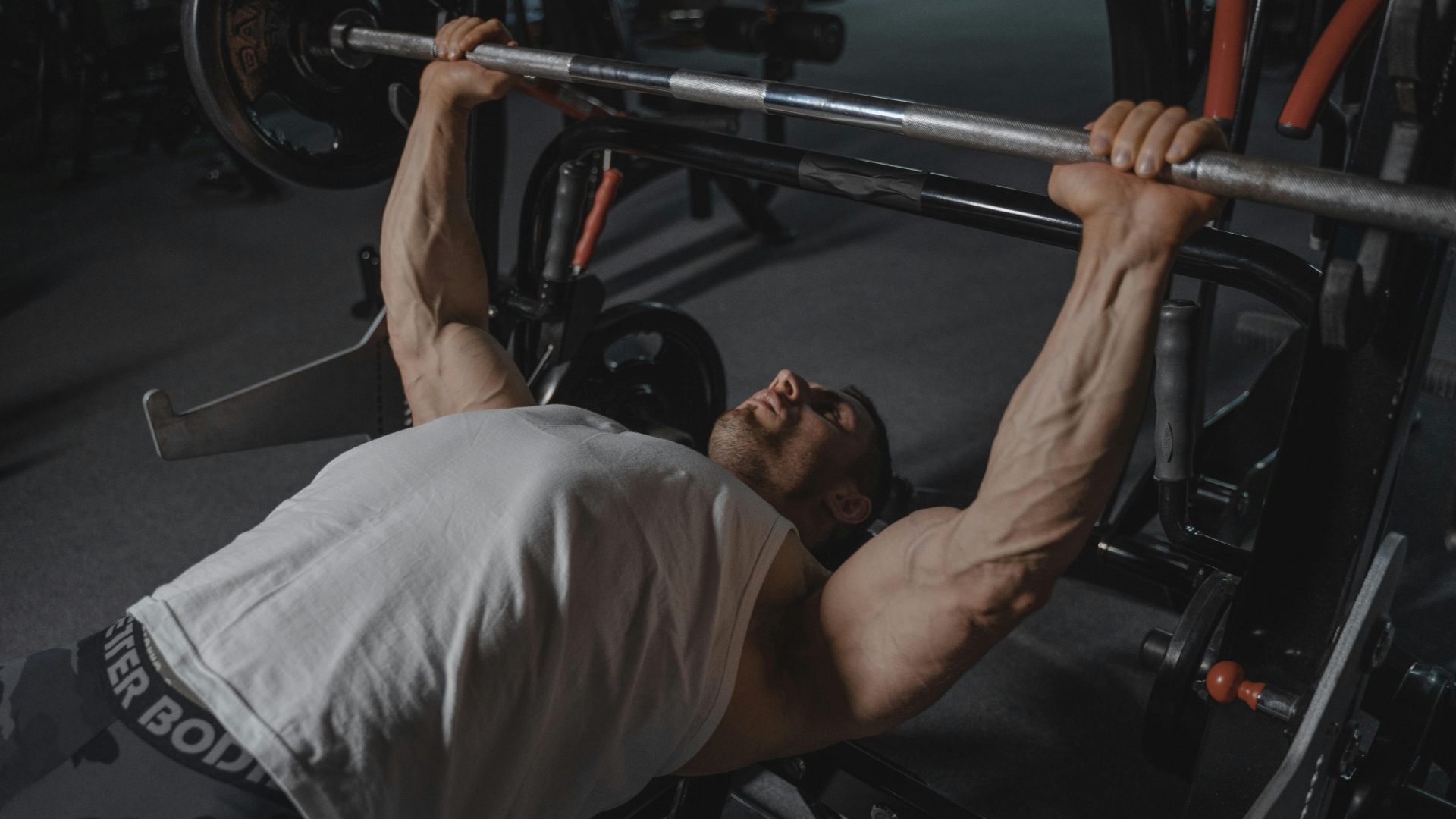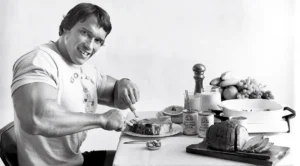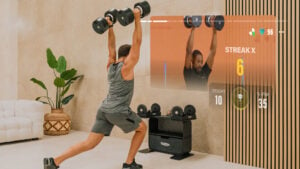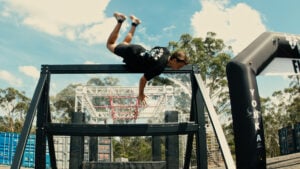When you think of a gym, the chances are the first picture that comes to your mind is of someone lying on a bench and grunting out rep after rep with a loaded Olympic bar. And for good reason. The bench press is one of the best exercises for your upper body, and knowing how to bench press properly is important for anyone looking to get into shape.
The bench press does a lot more for you than just giving you a sculpted physique. In a recent US study, researchers found that exercises such as the bench press can increase your bone density, while also improving your endurance. Another great thing about this exercise is its versatility. Depending on the muscles you want to target, you can also bench press with dumbbells and on incline and decline benches, as well as with different gripping techniques.
However, like other weight training exercises, there’s a right way and a wrong way to learn how to bench press. Not doing the bench press movement with proper form can cause shoulder, wrist or elbow injuries. Read on to find out how to make the most of this classic exercise while staying clear of injuries.
Jump To:
- The 8 Benefits Of The Bench Press
- How To Bench Press: 3 Common Approaches
- 11 Tips To Bench Press With Proper Form
- 1. Set Yourself Up
- 2. Unrack And Rerack Properly
- 3. Grip Correctly And Firmly
- 4. Grip Consistently
- 5. Keep Your Head, Shoulders And Back In Contact With the Bench
- 6. Keep Your Elbows Close
- 7. Arch Your Back
- 8. Set Your Shoulder Blades Right
- 9. Lower The Bar Down To Your Chest
- 10. Watch Your Weight
- 11. Stay Focused On Your End Goals
- The 8 Best Bench Press Variations
- 1. Close Grip Barbell Bench Press
- 2. Wide Grip Barbell Bench Press
- 3. One And One Quarter Incline Barbell Bench Press
- 4. Glute Bridge Dumbbell Bench Press
- 5. Alternating Dumbbell Bench Press
- 6. Top-Down Alternating Incline Dumbbell Bench Press
- 7. Incline Dumbbell Crush Press
- 8. Decline Dumbbell Bench Press
- Final Thoughts
- The Boss Hunting Fitness Reviewer — Jono Castano, Certificate IV in Fitness, Precision Nutrition Level 1
The 8 Benefits Of The Bench Press
Few other exercises can match the bench press when it comes to building the upper body. One recent study comparing the bench press with push-ups found that for men, the bench press was far more effective than push-ups in building muscle.
Here are eight more benefits that come from grabbing that bar and cranking out some good, solid reps.
1. Greater Upper Body Strength
The bench press is an exercise that works out nearly every part of your upper body, including the chest, arms, shoulders, back, abs, and even neck muscles. This means your bench press gains can easily be carried over to other upper body exercises, such as the shoulder press and the bicep curl.
2. Gauging Upper Body Strength
The bench press has for years been the gold standard for measuring upper body strength. If you’re not sure how you’re feeling when you arrive in the gym, hit an exercise like the bench press that you’ve done before and if it feels harder than normal, it might be time for an easier day.
3. Bigger Chest
The bench press, despite being a great compound lift, primarily targets the chest. As a result, being good at the bench press means developing a wide and muscular chest – a prerequisite to securing the classic male V-taper.
4. Stronger Serratus Anterior
The serratus anterior muscles surround your ribs and play a key role in shoulder and arm movements common to most sports. Bench pressing develops these muscles, so if you value your athletic performance as much as your physique, mastering your bench press form will help.
5. Sculpted Shoulders
The bulging shoulders of many experienced bench pressers prove that the bench press is one of the best shoulder exercises. Your shoulders bear a large share of the load as you perform a bench press, so a routine will keep them in good shape.
6. Developed Triceps
Want upper arms that are bursting through your shirtsleeves? Focus on building bigger triceps.
Few exercises work your triceps as the bench press does. Like your shoulders, your triceps bear a good share of the load as you lift, lower and balance weights above your chest in a supine position. This makes the bench press one of the best tricep exercises for men.
7. Better Bone Health
Lifting heavy weights does not develop your muscles alone, it also makes your bones stronger. And since the bench press engages a number of body parts, ranging from your chest to your arms to your shoulders to your back, it is a great exercise to strengthen your bones and joints in all of these areas.
8. Flexible Training
Unlike other fitness equipment, barbell and dumbbell bench press exercises can be used in various positions, depending on the body part you wish to exercise. This makes bench presses among the most flexible exercises around.
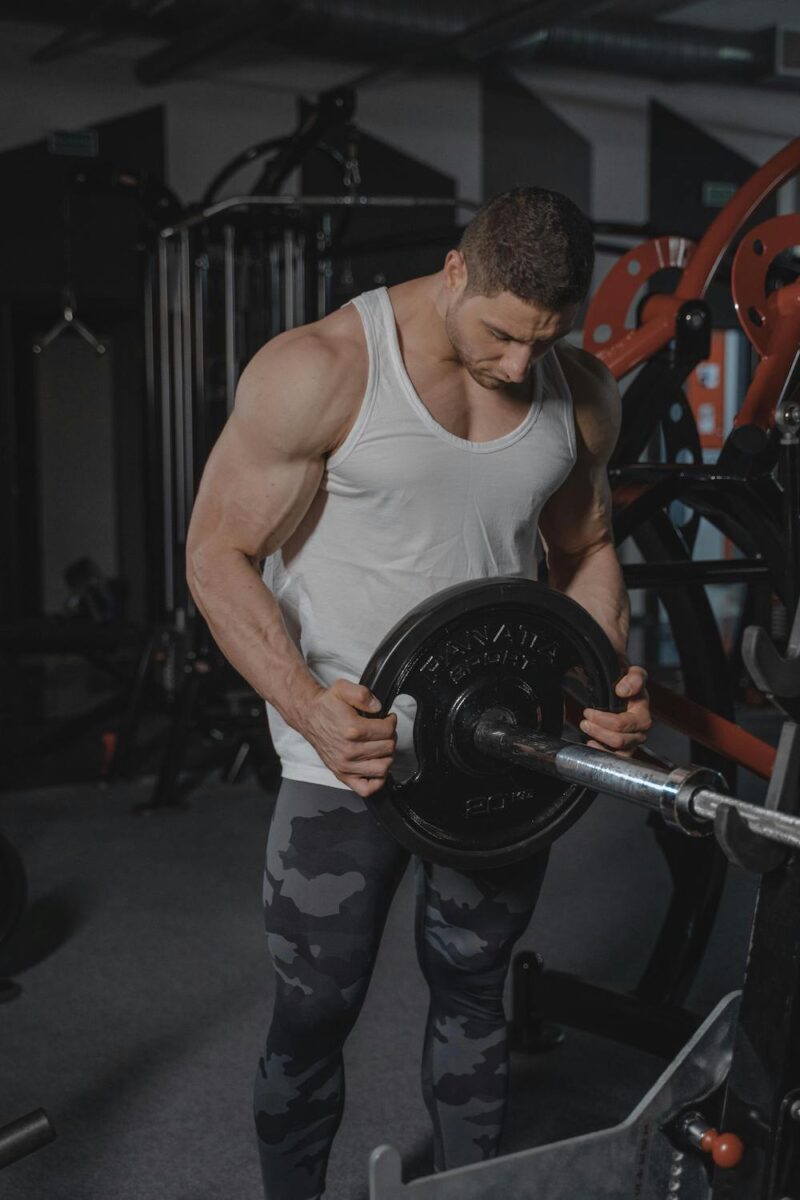
How To Bench Press: 3 Common Approaches
There are many ways to perform the bench press (more on those later). But whichever form you choose, it’s important to do it right. Here are three of the most common forms.
Flat Bench Press
Sets: 3
Reps: 5-12
Rest: 60 seconds
This is the form that most people have in mind when they think of the bench press.
Depending on the weight you’re handling, complete three sets of 5-12 reps.
Equipment: Flat Bench, Barbell
- Lie supine on the bench. Your knees should be bent and your feet should be flat on the floor. The barbell should be aligned with your shoulders.
- With your arms slightly wider than your shoulders, grip the bar with your thumb curled around it. Your palms should be facing your feet. Press your feet into the floor, keep your hips on the bench and your spine in a straight line. Arch your back.
- Slowly lift the bar off the rack and hold it still above yourself for a moment; then, while inhaling, slowly lower the bar so it touches your chest at nipple level. As you’re lowering the bar, keep your elbows bent out to the side and ensure that your in-breath is in lockstep with the movement of your arms. Stop lowering – and inhaling – when your elbows are just below the bench.
- Pause for a moment; then, keeping your feet firmly planted on the floor and your hips and back in contact with the bench, slowly raise the bar above your chest until your arms are straight, exhaling as you raise the bar.
Incline Bench Press
Sets: 3
Reps: 5-12
Rest: 60 seconds
A variation of the classic bench press, this form focuses on developing your upper chest and shoulders.
Depending on the weight you’re handling, complete three sets of 5-12 reps.
Equipment: Inclined Bench, Barbell
- Ensure that your bench is angled between 45 and 60 degrees. Lie on it with your feet flat on the floor and your back resting flat against it. The barbell should be aligned with your shoulders.
- Assuming a grip slightly wider than your shoulders, grip the bar with your thumbs curled around it and your palms facing your feet.
- Lift the bar slowly off the rack and hold it for a moment above yourself; then, while inhaling, slowly lower the bar so that it touches your chest at nipple level. As you’re lowering the bar, keep your elbows bent out to the side and ensure that your in-breath is in lockstep with the movement of your arms. Stop lowering – and inhaling – when the bar touches your chest.
- Pause for a moment; then, keeping your feet firmly planted on the floor and your hips and back in contact with the bench at all times, slowly raise the bar above your chest until your arms are straight, exhaling as you raise the bar.
Decline Bench Press
Sets: 3
Reps: 5-12
Rest: 60 seconds
This exercise focuses on developing lower chest muscles.
Depending on the weight you’re handling, complete three sets of 5-12 reps.
Equipment: Declined Bench, Barbell
- Ensure that your bench is positioned at a 15-degree angle, with your legs higher than your head. Lie on it with your feet flat on the base beneath them and your back resting against the bench. The barbell should be aligned with your shoulders.
- Assuming a grip slightly wider than your shoulders, grip the bar with your thumbs curled around it and your palms facing your feet.
- Lift the bar slowly off the rack and hold it for a moment above yourself; then, while inhaling, slowly lower the bar so that it touches your chest at nipple level. As you’re lowering the bar, keep your elbows bent out to the side and ensure that your in-breath is in lockstep with the movement of your arms. Stop lowering – and inhaling – when the bar touches your chest.
- Pause for a moment; then, keeping your feet on the floor and your hips and back on the bench, slowly raise the bar until your arms are straight, exhaling as you raise the bar.
11 Tips To Bench Press With Proper Form
While it takes practice to master a flawless bench press form, by following these bench press tips, you should be pressing like a pro in no time.
1. Set Yourself Up
When you’re lying on the bench, where is the barbell? If it’s not directly above your eyes, you need to adjust your position as handling weights below or above your eye level could lead to injury.
Similarly, how high is the bar above you when it’s racked? No matter how long your arms are, the bar shouldn’t be any higher than your wrists when your arms are locked out above you. Any higher and you’ll be straining unnecessarily to grab the bar (and breaking tip 5!); any lower and you won’t be exercising your muscles through their full range of motion.
2. Unrack And Rerack Properly
Safe bench pressing is good bench pressing. Whenever possible, you should bench press with a spotter – someone standing behind your head who can not only encourage you when you’re fighting to squeeze out those last precious reps but who can also grab the bar if you suddenly lose your strength.
When you unrack the bar, hold it firmly in position above your shoulders before lowering it for a count of 1-2 seconds. At the end of a set, rerack the bar by making sure that it’s resting in its rack before you release it from your hands.
3. Grip Correctly And Firmly
Having a good grip is essential to safe bench pressing. While chalk can certainly help you keep your grip, what’s most important is the width of your grip, which should be slightly wider than your shoulders. A grip that’s too wide could place too much stress on your shoulders, while one that’s too narrow could do the same for your elbow joints.
When handling heavy weight, it’s worth squeezing the bar as hard as you can before unracking for 1-2 seconds as this will warm up your muscles. If you can get your hands on a pair of wrist wraps, that’s even better as they’ll provide support to your wrists, helping prevent injuries.
Finally, make sure that you curl your thumbs around the bar instead of just gripping it with your fingers. Without a thumb grip, the bar could suddenly slip out of your hand – the last thing you want when you’re pressing a loaded bar above your head.
4. Grip Consistently
Along with holding the bar properly, it’s also important to always hold the bar the same way, depending on the exercise you’re doing.
If you’re working on your triceps with the close grip barbell bench press, always hold the bar in the same place, as the width of your grip will determine the muscles you work on. The last thing you want is to think you’re working on one muscle group when you’re actually exercising another, simply because your grip and hand positioning aren’t consistent.
5. Keep Your Head, Shoulders And Back In Contact With the Bench
As with your feet, your head, shoulders and back should always remain still and in contact with the bench as you’re handling a barbell. Any movement of these body parts away from the bench will not only mean losing drive and power in your lift, but it could also result in injury.
To get the most drive for your lift off the bench, squeeze your shoulder blades as you lower the bar to your chest.
6. Keep Your Elbows Close
The exact position of your elbows when bench pressing will always vary, depending on the nature of the exercise you’re performing. A classic bench press with a barbell, for example, will always entail more outward movement of the elbows than, say, an incline bench press with dumbbells. This is because both exercises position your body in different ways.
All the same, whichever exercise you’re performing, always strive to keep your elbows as close to your torso as possible, as this will not only minimise the chance of injury but will also help you to isolate the muscles the exercise is meant to develop. A great way to keep your elbows close is to not rush your movements – especially when you’re lowering weights. Instead, just lift and lower the weights in a measured, uniform manner.
7. Arch Your Back
Arching your back during a bench press is a somewhat contentious topic within the lifting community. Professional powerlifters always arch their backs during the bench press as this allows them to lift more weight by reducing the distance travelled by the bar. However, arching the back does more than just allow you to lift more weight – it also allows for more efficient recruitment of the shoulder muscles, upper back and lower pec, thus enabling a more stable bench pressing position.
As long as you don’t have any pre-existing back conditions you should be fine with arching your back provided you do it with proper form.
As an added safety measure, it’s worth investing in a weightlifting belt, as wearing one while bench pressing will provide support for your arched lower back. It’ll also support your serratus anterior muscle, which is one of the muscles that any bench press exercises.
8. Set Your Shoulder Blades Right
After your chest and your arms, your shoulders bear the bulk of the load of the bar in a bench press. This means that improper form can put unnecessary strain on the shoulder joint resulting in shoulder pain.
To avoid this, it’s important that you keep your shoulder blades in one place throughout the exercise to maximise the drive you gain from pressing your shoulders against the bench. Moving your shoulders will not only decrease your ability to lift more weight, it also increases your risk of injury.
The best way to stabilise your shoulder blades before a bench press session is to try to pull them back and down behind you. Visualise your shoulder blades being tucked into the bench, then keep them there for the duration of your session.
9. Lower The Bar Down To Your Chest
Walk into any gym and you’re likely to see people having all sorts of contact with the barbell as they bench press. Some may bounce it off their chest; others may brush the bar off their collarbones; some may not touch their chests at all.
Correctly touching your chest during the bench press ensures that your muscles are properly exercised by making them go through the entire range of motion. It also affords a sense of rhythm to your movements, which, over time, will help you to perfect your bench press form.
To bench press properly, make sure that the bar gently touches your chest for a moment – half a second is enough – before raising it again.
10. Watch Your Weight
If you are new to lifting weights, it’s easy to be impressed – and inspired – when watching an accomplished athlete bench press a heavy weight with relative ease. But it’s also worth remembering that, at one point, they were inexperienced and probably lacked the physique they now have. In other words, they were once in your position.
Everyone starts their lifting journey with simple exercises and modest weights, before increasing their load as their strength and skill develop. However, unglamorous it may be, it’s that slow and steady path that got them to where they are today. There are no exceptions to this rule whatsoever.
Try to do the same when you bench press. Never lift weights that are too heavy or perform presses you’re not ready for, as you could injure yourself. Instead, practise exercises that are appropriate for your skill level; then, once you’ve mastered them, move on to more challenging ones.
11. Stay Focused On Your End Goals
What are your fitness goals? Do you just want a stronger, more developed physique? Or are you more interested in losing weight to improve your overall health?
Either way, the bench press can become an important part of your exercise routine. The difference lies in the frequency and intensity with which you train.
As part of a broader nutrition and exercise program, the bench press can, like other weight exercises, help you to lose weight fast. And if you’ve got a busy work schedule, half an hour at the gym can make the bench press one of the best lunch break exercises. Or maybe, having found the best exercise bike for your aerobic workout, you now need a simple but effective exercise for your anaerobic workout.
Whatever your goals, the bench press is a great exercise that can fit right into your broader health and fitness routine.
The 8 Best Bench Press Variations
- Close Grip Barbell Bench Press
- Wide Grip Barbell Bench Press
- One And One Quarter Incline Barbell Bench Press
- Glute Bridge Dumbbell Bench Press
- Alternating Dumbbell Bench Press
- Top-Down Alternating Incline Dumbbell Bench Press
- Incline Dumbbell Crush Press
- Decline Dumbbell Bench Press
We’ve looked at the classic bench press, as well as the inclined bench press, both staple exercises of any upper body workout. But to pay proper attention to all of your muscles, and to keep things interesting, it’s worth practising a variety of bench press exercises in both their barbell and dumbbell bench press forms.
Here are eight more bench press variations to keep you in shape.
1. Close Grip Barbell Bench Press
This exercise is best for developing your triceps. It’s also great for your lower arm definition, making it one of the best forearm exercises.
Equipment: Flat Bench, Barbell
- Lie supine on the bench, with your knees bent and feet flat on the floor. The barbell should be aligned with your shoulders.
- With your arms slightly narrower than your shoulders, grip the bar with your thumbs curled around it. Your palms should be facing your feet. Press your feet into the floor, keep your hips on the bench and your spine in a straight line. Arch your back slightly so that your shoulders press into the bench..
- Slowly lift the bar off the rack and hold it still above yourself for a moment. Now slowly lower the bar until it touches your chest, all the while inhaling deeply. As you’re lowering the bar, keep your elbows bent at an acute angle and ensure that your in-breath is in lockstep with the movement of your arms.
- Once the bar touches your chest, push it back explosively until your arms lock out. Exhale as you lift the bar.
2. Wide Grip Barbell Bench Press
This exercise is ideal for developing your chest muscles, as well as your shoulder and abdominal muscles.
Equipment: Flat Bench, Barbell
- Lie supine on the bench, with your knees bent and your feet on the floor. The barbell should be aligned with your shoulders.
- With your arms wider than your shoulders, grip the bar with your thumbs curled around it. Your palms should be facing your feet. Press your feet into the floor, keep your hips on the bench and your spine straight. Arch your back a little, driving your shoulders into the bench.
- Slowly lift the bar off the rack and hold it still above yourself for a moment; then, while inhaling, slowly lower the bar so that it touches your chest at nipple level. As you’re lowering the bar, keep your elbows bent out to the side and ensure that your in-breath is in lockstep with the movement of your arms. Stop lowering – and inhaling – when your elbows are just below the bench.
- Once the bar touches your chest, push it back explosively until your arms lock out. Exhale as you lift the bar.
3. One And One Quarter Incline Barbell Bench Press
Another great upper chest and shoulders exercise, this variation helps pump up the chest by forcing you to eke out quick reps with little rest. This increases the blood flow to the target muscle group, helping them to grow big faster.
Equipment: Inclined Bench, Barbell
- Place the barbell on the rack above the bench. Ensure that your bench is positioned at a 45-degree angle, then sit on it with your feet flat on the floor and your back resting against it. The barbell should be aligned with your shoulders.
- Assume a shoulder-width grip, with your thumbs curled around the bar and your palms facing your feet.
- Slowly lift the bar off the rack and hold it still above your body for a moment; then, while inhaling, slowly lower the bar so that it touches the nipple level of your chest. As you’re lowering the bar, keep your elbows bent out to the side and ensure that your in-breath is in lockstep with the movement of your arms.
- Once the bar touches your chest, push it halfway back up, then back down to your chest, and then back up again until your arms are locked out. Remember to exhale as you push the bar back up the first time, inhale when you bring it back down, and then to exhale again when you fully push it back up again.
4. Glute Bridge Dumbbell Bench Press
As the name suggests, this dumbbell bench press variation gives your glute muscles – your backside – a workout, as well as your abdomen and upper body.
Equipment: Flat Bench, Dumbbells
- Lie perpendicular to your bench, with only the back of your head, your neck and your upper back resting against the centre of your bench. Your back should be straight and your legs bent at 90 degrees. Your bench should be low enough so that, while in this position, you can comfortably lift your dumbbells off the floor.
- Pick up your dumbbells and hold them against your shoulders – this is where you’ll start.
- Keeping your body straight and still, lift both dumbbells until your arms lock out. Tapping the ends of your dumbbells against one another as your arms lock out is a good way to mark the end of this movement.
- Hold the dumbbells above your shoulders for a moment, then slowly lower your arms with your elbows bent at an oblique angle until your elbows are below the bench – low enough so that you can feel a good stretch in your chest. Remember to inhale as you lower your arms.
- Hold this position for a moment, then exhale as you lift the dumbbells again.
5. Alternating Dumbbell Bench Press
Like other dumbbell bench press exercises, this dumbbell bench press is useful for developing balanced musculature, given that both hands have to handle an equal share of the weight you’re handling.
Equipment: Flat Bench, Dumbbells
- Lie supine on your bench. Your bench should be low enough so that while in this position, you can comfortably lift your dumbbells off the floor.
- Pick up your dumbbells and hold them against your shoulders. This is where you’ll start.
- Keeping your body still and straight, exhale as you lift one dumbbell until your arm locks out. Hold the position for a moment, then slowly lower your arm with your elbow at an acute angle until your elbow is below the bench. Remember to inhale as you lower your arm.
- Repeat this movement with your other arm.
6. Top-Down Alternating Incline Dumbbell Bench Press
This dumbbell bench press is almost identical to the alternating dumbbell bench press with the difference that this one lays greater stress on developing your upper chest.
Equipment: Inclined Bench, Dumbbells
- Ensure that your bench is positioned at a 45-degree angle, then sit on it with your feet on the floor and your back resting against it. Your bench should be low enough so that you can pick your dumbbells up off the floor.
- Pick up both dumbbells and hold them above your shoulders, their ends touching one another. This is where you’ll start.
- Keeping one arm still, lower your other arm, turning it slightly as you lower it so that your elbow is at an acute angle when the dumbbell reaches your shoulder. Remember to inhale as you lower the weight.
- Hold the dumbbell at your shoulder for a moment, then lift it back to the starting point, exhaling as you do so. Repeat this movement with your other arm.
The movement of one arm, followed by the other, constitutes one repetition in this dumbbell bench press.
7. Incline Dumbbell Crush Press
Another great upper body exercise, this dumbbell bench press variation involves keeping the dumbbells closely together during the entire exercise, which makes it as much an exercise in concentration as a physical workout.
Equipment: Inclined Bench, Dumbbells
- Ensure that your bench is positioned at a 45-degree angle, then sit on it with your feet flat on the floor and your back resting against it. Your bench should be low enough so that you can pick your dumbbells up off the floor.
- Pick up your dumbbells and hold them gently on your chest, pressed together. This is where you’ll start.
- Lift both dumbbells in unison, keeping them pressed together as you move your arms upwards until they lock out. Remember to exhale as you’re lifting.
- Hold the dumbbells above your body for a moment, then slowly lower them back to your starting position, keeping them pressed together. Inhale as you lower the weights.
8. Decline Dumbbell Bench Press
A variation of the decline barbell bench press, this dumbbell bench press is ideal for working on your chest definition, as well as your shoulder strength.
Equipment: Declined Bench, Dumbbells
- Ensure that your bench is positioned at a 15-degree angle, with your legs higher than your head, then lie on it with your feet secure at the end of the bench. A spotter can hand you your dumbbells or, if you’re training alone, ensure that your bench is low enough to allow you to pick your dumbbells up off the floor.
- Keeping your back straight, lift your dumbbells so that you’re holding them end-to-end with your arms locked out above your upper chest. Your thumbs should be curled around the bars of your dumbbells and your palms should face your feet. This is where you’ll start.
- Slowly lower the dumbbells, inhaling as you push your elbows outwards. Lower the dumbbells until they reach your chest with your forearms and upper arms forming a 45-degree angle.
- Hold the dumbbells for a moment, then exhale as you lift them back up to the starting position.
Final Thoughts
Although the loaded Olympic barbell is the symbol of the bench press for many people, dumbbells can also be used in this exercise. In some cases, dumbbell bench presses can be more effective in targeting specific muscles.
The bench press has many benefits for those who are willing to practise it properly. While a larger and stronger upper torso is one of the obvious benefits, there’s also improved bone health. On top of that, the variety of exercises means you also get to keep your workout routine interesting.
Of course, it is important to learn how to bench press the right way. This is why it helps to practise tips such as holding a barbell correctly, keeping your body tight during bench press sets, being aware of your foot placement and beginning with lighter weights when you first start. It also helps to think about how regular bench pressing might fit with your broader fitness goals. To help you with this, it might be worth checking out our other fitness articles.
The Boss Hunting Fitness Reviewer — Jono Castano, Certificate IV in Fitness, Precision Nutrition Level 1
Jono Castano is a Sydney-based celebrity personal trainer and certified nutrition coach who specialises in fitness, training, workouts and diet plans. He is the co-founder of the popular Acero fitness brand and fitness app and has become well-known for his extensive work with noted figures like Rebel Wilson, Jessica Mauboy, Lincoln Lewis, Joel Creasy, and The Veronicas.
Jono has built a large social media following with over 800,000 subscribers on Instagram. He has also been profiled by publications such as Men’s Health and has become one of the most recognisable fitness instructors in Australia.
Expertise: Fitness, Training, Personal Training, Workouts, Diet Plan
Location: Sydney, Australia
Credentials: Certificate IV in Fitness, Precision Nutrition Level 1
Editor’s Note: The fitness content on Boss Hunting is informative in nature, but it should not be taken as medical or professional fitness advice. When starting a new training regimen and/or diet, consulting with a trusted medical professional or trainer is always a good idea.
Did you enjoy this article on the best shoulder exercises? Check out a few of Boss Hunting’s other workout guides below:
- The 15 Best Ab Workout Exercises
- The 12 Best Shoulder Exercises For Improved Strength & Size
- The 15 Best Exercises For The Perfect Leg Workout
- The 16 Best Chest Exercises & Workouts For Men
- The 15 Best Bicep Exercises & Workouts For Men
- The 21 Best Rear Delt Exercises For Boulder Shoulders
- The 11 Best Tricep Exercises For Improved Strength & Size
- The 15 Best Exercises For The Perfect Leg Workout
- The 9 Best Lat Exercises For When Size Is The Prize
- The 16 Best Oblique Exercises & Workouts For Men
- The 13 Best Trap Exercises & Workouts For Men
- The 10 Best Forearm Exercises & Workouts For Men
- 5 First Time Marathon Tips From Olympic Runner Brett Robinson
- The 25 Best Dumbbell Exercises & Workouts You Don’t Need A Gym For
- Why The 75 Hard Challenge Can Work For You
For more information to consider about diet, nutrition and, fitness equipment, check out below:
- Does Intermittent Fasting Actually Work? We Tested It Out
- How To Lose Weight Fast: 10 Simple Tips To Shed Fat More Efficiently
- The 7 Best Massage Guns You Can Buy In Australia
- The 13 Best Exercise Bikes To Stay Fit This Winter
- The 22 Best Mountain Bikes Money Can Buy Right Now
- The 16 Best Electric Bikes In Australia
- 8 Best Tennis Shoes for Men in Australia
For some celebrity inspiration, check out our celebrity workout guides right here:
- Henry Cavill’s Workout Routine Will Unleash Your Inner Superman
- The Workout That’ll Get You ‘Gladiator 2’ Ripped Like Paul Mescal
- The Chris Hemsworth Workout & Diet Plan Is Inhuman
- Jake Gyllenhaal’s Workout & Diet Plan To Get ‘Road House’ Ripped
- How Jeremy Allen White Got Calvin Klein Model-Jacked
- Joe Rogan’s Workout & Diet Plan Isn’t For The Faint-Hearted
- How Hugh Jackman Trained For His MCU Return In ‘Deadpool & Wolverine’
- Daniel Craig’s Military-Inspired Workout For ‘No Time To Die’
- How Michael Jordan’s Personal Trainer Helped Him Achieve GOAT Status
- The Bruce Lee Workout That Made His Rig Famous
- The Rock’s Intense Workout For ‘Hobbs & Shaw’ Will Bring You To Your Knees
For the best places to improve your health and fitness, check out our recommendations here:
